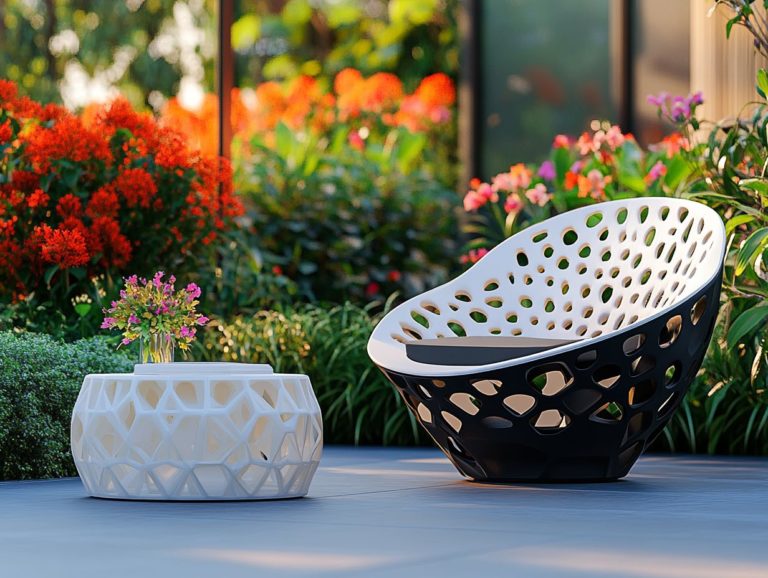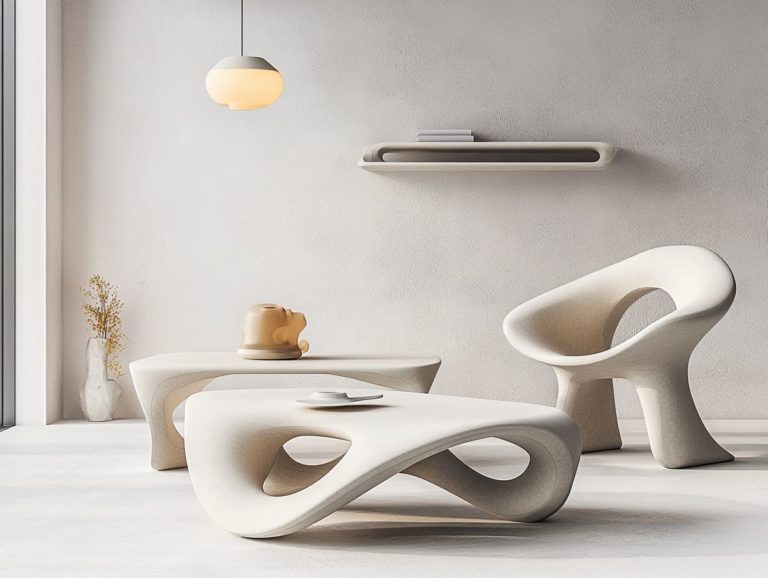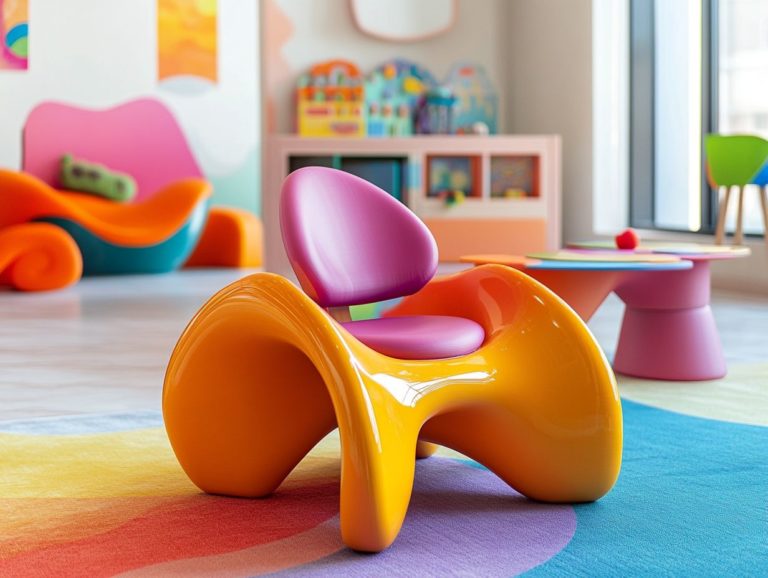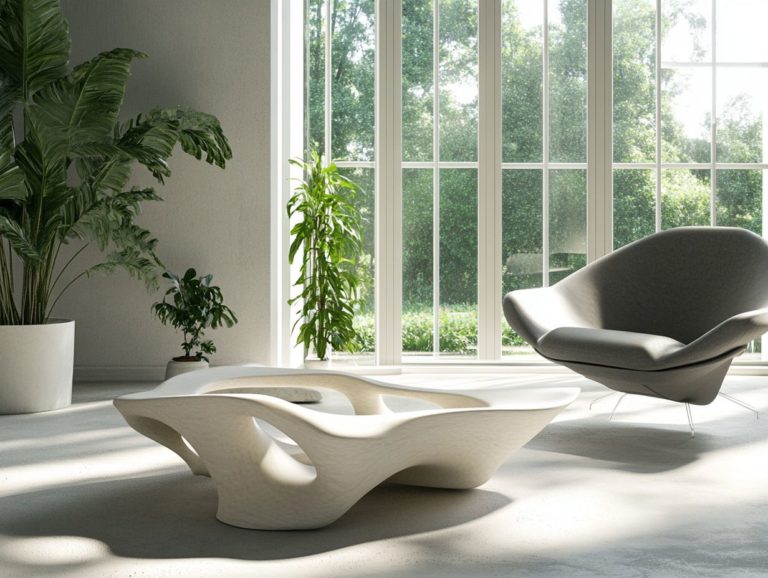5 Unique Benefits of 3D-Printed Furniture
The world of furniture design is undergoing a remarkable evolution, with 3D printing leading the charge in this exciting transformation.
By embracing customizable designs and personalization options, 3D-printed furniture presents unique advantages that traditional manufacturing cannot compete with. It significantly reduces waste, minimizes environmental impact, and speeds up production times while ensuring lightweight durability. It also offers a cost-effective solution for today’s consumers.
Discover the exciting benefits of 3D-printed furniture that could change how you think about design! This article delves into the many benefits of 3D-printed furniture, the materials utilized, its limitations, and its potential to revolutionize the industry.
Contents
Key Takeaways:
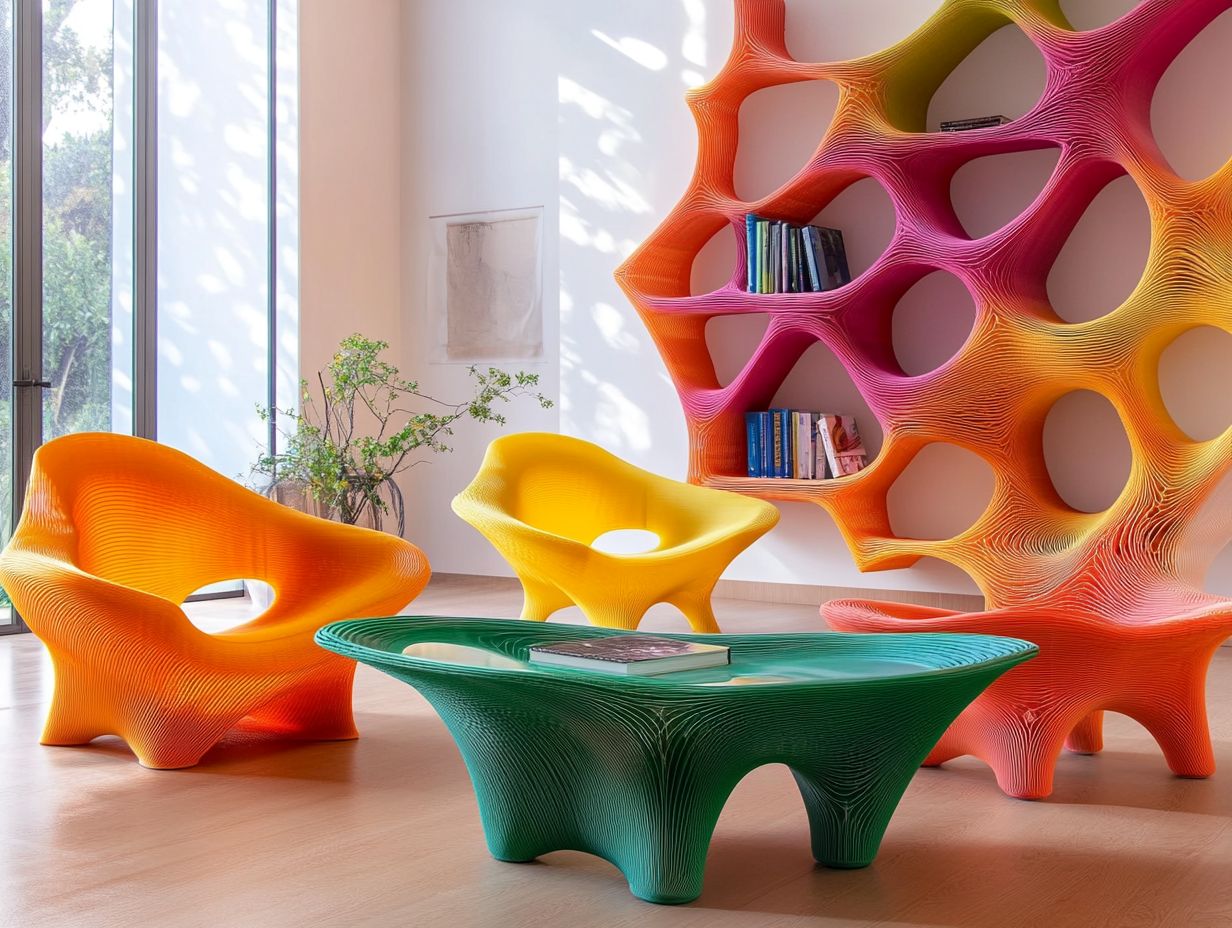
- Customize and personalize your furniture designs with 3D printing technology, making them truly one-of-a-kind.
- Reduce waste and environmental impact with 3D-printed furniture, as only the necessary materials are used in production.
- Save time with faster production of 3D-printed furniture, allowing for quicker delivery and assembly.
1. Customizable Designs and Personalization
In the ever-evolving landscape of the furniture industry, customizable designs and personalization have taken center stage through the lens of 3D-printed furniture. This technology enables furniture designers to craft unique shapes and tailored products that resonate with your preferences.
This shift highlights the importance of customization in the design process. Each piece can become a genuine reflection of your personal style. Computer-aided design files help in creating custom designs, allowing designers to manipulate dimensions and aesthetics with precision.
With advanced software, the design workflow becomes seamless and flexible. You, as both a designer and a consumer, can visualize and modify elements in real-time. The furniture market is increasingly attuned to individual tastes, making bespoke solutions inviting and desirable.
2. Reduced Waste and Environmental Impact
One of the most compelling advantages of 3D printing in the furniture industry is its ability to reduce consumer waste and environmental impact. For a deeper understanding of this topic, explore the environmental impact of 3D-printed furniture. This technology revolutionizes manufacturing methods using sustainable and biodegradable materials.
Unlike traditional manufacturing processes, which often leave surplus materials and consume excessive energy, 3D printing offers a precise layer-by-layer construction method that minimizes waste. This technology allows you to produce custom designs directly from digital files, creating efficiencies that conventional methods cannot match.
Embracing this approach fosters an eco-friendly mindset. It enables furniture designers and manufacturers to explore innovative shapes and functionalities without the limitations of mass production. The furniture sector can gain immensely from these sustainable practices, paving the way for a greener future.
3. Faster Production Time

Faster production times are transforming the furniture industry. By embracing 3D printing technologies, you can design rapidly and manage inventory efficiently, allowing you to respond swiftly to ever-changing consumer demands.
This game-changing method speeds up production, letting you create and iterate designs in a fraction of the time traditionally required. For instance, a well-known furniture brand managed to slash its lead time from months to mere weeks, thanks to the swift production capabilities that 3D printing offers. With prototypes produced on-demand, you gain the flexibility to experiment with various materials and designs without incurring significant costs associated with traditional methods.
Integrating industrial robots into your manufacturing process enhances efficiency. These robots automate repetitive tasks and ensure a high level of precision, contributing to your overall productivity. Together, these advancements enable you to close the gap between design and production, ultimately leading to more tailored products shaped by real-time market feedback.
4. Lightweight and Durable
The integration of 3D printing in furniture design allows you to create pieces that are both lightweight and durable. For ideas on enhancing your home, check out how to style your space with 3D-printed furniture, which enhances ergonomics and performance without sacrificing quality.
This innovative approach not only streamlines production but also lets you explore complex shapes and structures that traditional manufacturing methods often limit. Imagine crafting chairs or tables from polymers that offer both strength and visual allure. This is perfectly suited for modern consumers who value style and functionality.
The versatility of 3D printing provides customized solutions tailored to individual preferences and space constraints. Each piece can feel uniquely personal. As advancements in this technology continue, the potential for crafting sustainable, eco-friendly designs grows ever more attainable, aligning with the increasing demand for environmentally-conscious products in today s market.
5. Cost-Effective
Cost-effectiveness is a hallmark of 3D printing, a game-changing manufacturing method that significantly reduces material costs while streamlining inventory management in the furniture industry.
By minimizing waste during production and embracing on-demand manufacturing, you can allocate resources more efficiently. This flexibility allows you to adapt designs to cater to unique preferences seamlessly.
Unlike traditional methods that often require hefty upfront investments for tooling and setup, this technology enables you to produce limited runs or custom pieces without breaking the bank. As a result, you can see profit margins expand while simultaneously enhancing customer satisfaction, making 3D printing an increasingly appealing choice for brands eager to remain competitive in a rapidly evolving market.
What Is 3D Printing?
3D printing, often referred to as additive manufacturing, is changing the game, offering incredible new possibilities! This technology crafts three-dimensional objects by layering materials derived from digital models, typically designed with advanced CAD software.
How Does It Work?
The journey begins with a digital blueprint, meticulously crafted through Computer-Aided Design (CAD) files. This process allows for intricate detailing and customization that was once unimaginable. Once you finalize the design, the 3D printer employs various layering techniques such as melted plastic layering or liquid resin curing to construct the object layer by layer, ensuring exceptional precision.
The digital essence of this technology enhances accuracy and opens the door to limitless design possibilities. It enables engineers and designers to prototype rapidly, innovate on-the-fly, and minimize waste compared to traditional subtractive manufacturing methods. This shift leads to more sustainable production practices, making you part of a forward-thinking revolution in manufacturing.
Explore how you can transform your furniture designs with 3D printing today!
What Materials Can Be Used for 3D-Printed Furniture?
You have a remarkable array of materials at your disposal for 3D printing furniture, including cutting-edge options like PLA, polymers, and sustainable bioplastics.
Each of these materials delivers functional benefits while adding aesthetic value to your creations.
These choices offer a distinctive combination of features, perfectly aligned with the evolving desires of modern designers and environmentally conscious consumers.
For example, PLA is lightweight and easy to manipulate. It also shines with a sustainable edge, being derived from renewable resources like corn starch.
In contrast, polymers are strong and resilient, ideal for furniture designed to endure everyday use.
Sustainable bioplastics enhance your options by contributing to lower carbon footprints, appealing to those who prioritize eco-friendly choices.
With such a diverse selection of materials, you can unleash your creativity while ensuring that your final products meet the demands of durability and style that today s consumers expect.
What Are the Limitations of 3D-Printed Furniture?
Despite its many advantages, 3D-printed furniture has certain limitations that you should consider.
You might encounter potential design flaws and face challenges in achieving the same production efficiency as traditional manufacturing methods.
One major concern is the inconsistency in material strength, which can result in weakened structures that struggle to withstand daily wear and tear.
The limited range of materials suitable for 3D printing can restrict your design choices, forcing you to make compromises that may not align with industry standards.
While traditional manufacturing techniques often deliver a reliable level of durability and uniformity, 3D printing might not always produce highly detailed and complex geometries without sacrificing structural integrity.
These drawbacks emphasize the delicate balance between innovation and practicality in your furniture design journey.
How Can 3D Printing Revolutionize the Furniture Industry?
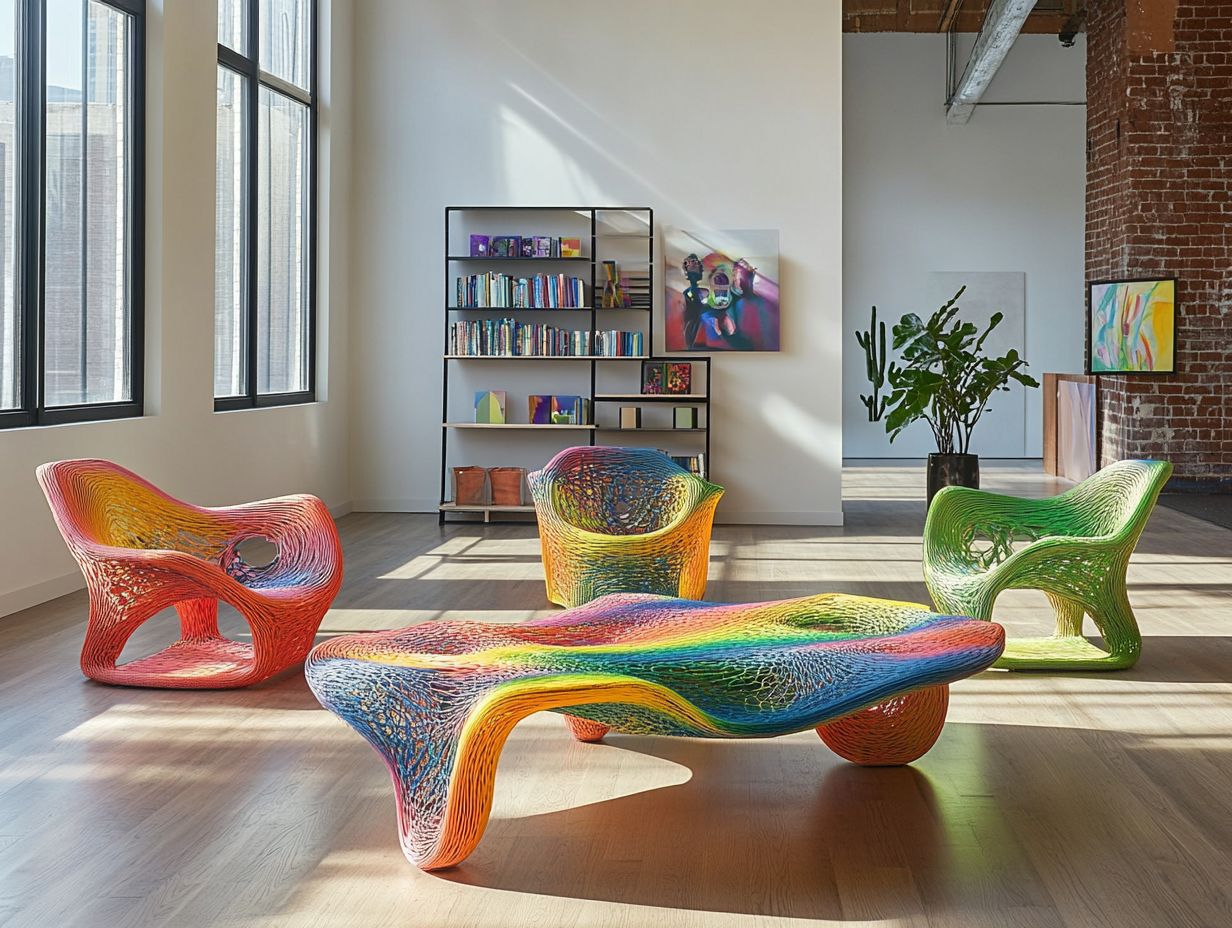
3D printing is set to revolutionize the furniture industry, offering you innovative designs and enhanced customization options that align perfectly with your evolving preferences and needs.
This technology enables you to create unique pieces tailored to your individual taste while significantly speeding up the prototyping phase.
Designers can now bring their visions to life much quicker than with traditional methods.
As manufacturers eagerly adopt this shift, they discover that design flexibility allows you to influence both the look and functionality of products, fostering a more personal connection between you and your furniture.
In this dynamic landscape, your expectations are being redefined, compelling industries to innovate and keep up with your growing appetite for bespoke solutions.
What Are the Potential Applications of 3D-Printed Furniture?
3D-printed furniture offers exciting possibilities beyond just looks; it can transform industries like healthcare, where unique shapes and ergonomic designs enhance patient comfort and accessibility. To make the most of this innovation, consider exploring 5 ways to personalize your 3D-printed furniture.
In the realm of healthcare, for instance, you can see how specialized seating and support systems can be tailored to individual patients.
This customization ensures that specific medical needs are addressed, ultimately leading to improved recovery outcomes.
But it doesn’t stop there. Sectors such as education are reaping the benefits of 3D-printed furnishings designed for flexibility and durability.
These innovations are crucial for creating adaptable classroom layouts that boost creativity and engagement.
The hospitality industry is also getting in on the action, utilizing this technology to craft bespoke furniture that elevates guest experiences while catering to diverse design preferences.
These varied applications highlight how 3D-printed furniture is not just a revolution in manufacturing; it s a powerful tool for addressing consumer needs across multiple fields.
What Are the Future Possibilities for 3D-Printed Furniture?
The future possibilities for 3D-printed furniture are expansive, driven by new technology and software innovations that enhance design capabilities and environmental sustainability. To explore this further, check out the best practices for designing 3D-printed furniture.
As these innovations emerge, the furniture industry will see an explosion of new design concepts. These concepts will combine functionality and artistic expression, enabling creators to redefine traditional craftsmanship.
New materials like bio-based plastics, which are made from natural sources, and recycled composites will become common. This shift nurtures a culture of sustainability in manufacturing.
This change aligns with consumer demand for eco-friendly products. It also boosts efficiency by reducing waste and energy consumption.
These advancements can transform furniture production, making it more accessible and personalized while integrating with Earth’s resources.
Frequently Asked Questions
What are the 5 unique benefits of 3D-printed furniture?
1. Customization: 3D printing allows for unique, personalized furniture pieces tailored to user needs, showcasing the benefits of customized 3D-printed furniture.
2. Cost-effective: It eliminates the need for expensive molds, making production cheaper.
3. Design flexibility: Designers can experiment with intricate designs, leading to innovative 3D-printed furniture pieces.
4. Sustainable: 3D printing reduces material waste and carbon footprints, making it eco-friendly.
5. Quick turnaround: It allows for faster production, resulting in quicker delivery of furniture orders.

